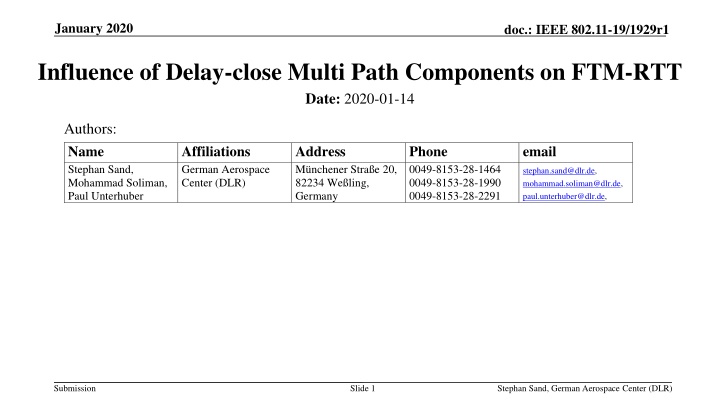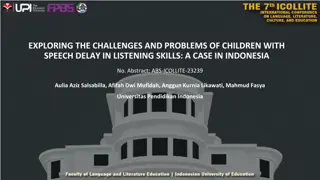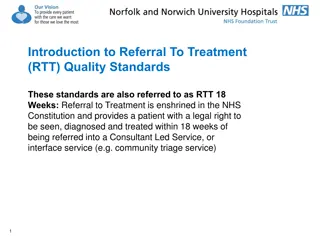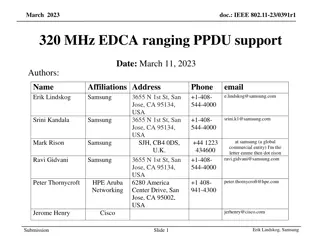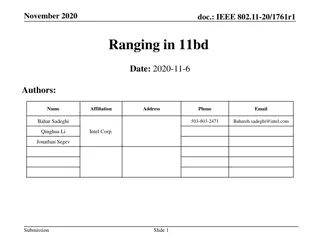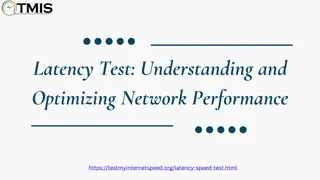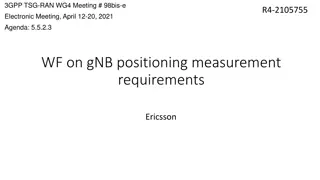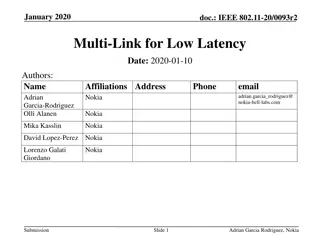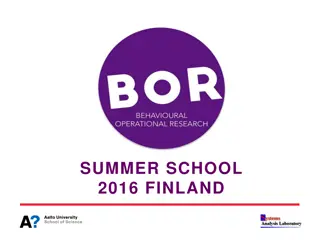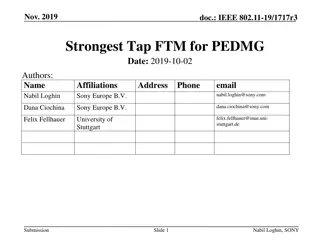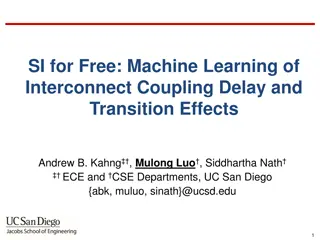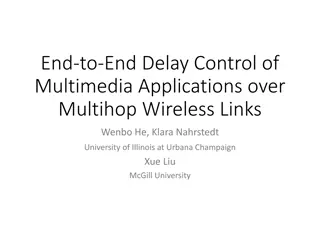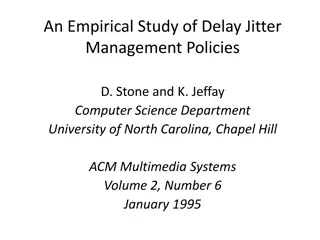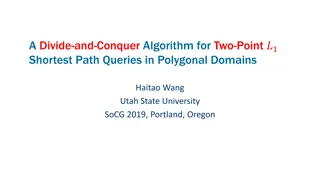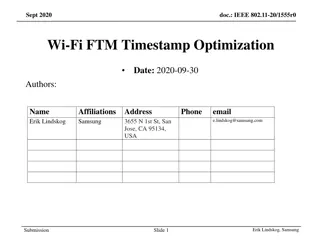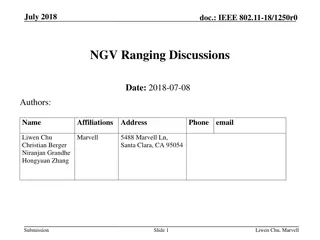Influence of Delay-close Multi Path Components on FTM-RTT Ranging Accuracy
Results discussion on the impact of delay-close Multi Path Components (MPCs) on FTM-RTT performance in IEEE 802.11-19/1929r1 document for NGV modes in 5.9 GHz band, emphasizing the need for larger bandwidth for improved ranging accuracy.
Download Presentation

Please find below an Image/Link to download the presentation.
The content on the website is provided AS IS for your information and personal use only. It may not be sold, licensed, or shared on other websites without obtaining consent from the author.If you encounter any issues during the download, it is possible that the publisher has removed the file from their server.
You are allowed to download the files provided on this website for personal or commercial use, subject to the condition that they are used lawfully. All files are the property of their respective owners.
The content on the website is provided AS IS for your information and personal use only. It may not be sold, licensed, or shared on other websites without obtaining consent from the author.
E N D
Presentation Transcript
January 2020 doc.: IEEE 802.11-19/1929r1 Influence of Delay-close Multi Path Components on FTM-RTT Date: 2020-01-14 Authors: Name Stephan Sand, Mohammad Soliman, Paul Unterhuber Affiliations German Aerospace Center (DLR) Address M nchener Stra e 20, 82234 We ling, Germany Phone 0049-8153-28-1464 0049-8153-28-1990 0049-8153-28-2291 email stephan.sand@dlr.de, mohammad.soliman@dlr.de, paul.unterhuber@dlr.de, Submission Slide 1 Stephan Sand, German Aerospace Center (DLR)
January 2020 doc.: IEEE 802.11-19/1929r1 Abstract [1], [2] present results on RTT ranging performance for 11bd NGV 10 and 20 MHz modes in 5.9 GHz band Optimistic performance results due to selected channel models This contribution: Influence of delay-close Multi Path Components (MPCs) on FTM-RTT ranging due to ground reflection (GR) For safety critical applications requirements on ranging accuracy cannot be met with high probability Larger bandwidth for improved ranging accuracy needed Submission Slide 2 Stephan Sand, German Aerospace Center (DLR)
January 2020 doc.: IEEE 802.11-19/1929r1 Influencing Factors for RTT Ranging Bandwidth Resolution in distance and delay Bandwidth / [MHz] Distance Resolution / [m] 30.00 15.00 0.3 Delay Resolution/ [ns] 100 50 0010 0020 1000 1 Operation frequency f and distance d Signal to Noise Ration (SNR) [1] ? ??? ? = ? ? ????????? ???????? ? ???= ??? ???? ???? Submission Slide 3 Stephan Sand, German Aerospace Center (DLR)
January 2020 doc.: IEEE 802.11-19/1929r1 One-Path Model Tx LOS Rx Tx Transmitter Rx Receiver LOS Line of Sight Submission Slide 4 Stephan Sand, German Aerospace Center (DLR)
January 2020 doc.: IEEE 802.11-19/1929r1 Two-Path Model Tx LOS Rx MPC Tx height Rx height Reflecting Surface Depending on phase of MPC constructive or destructive interference Worst case scenario MPC out-of-phase to LOS Tx Transmitter Rx Receiver LOS Line of Sight MPC Multi Path Component Submission Slide 5 Stephan Sand, German Aerospace Center (DLR)
January 2020 doc.: IEEE 802.11-19/1929r1 Simulation Settings (1) Single range simulations with [3]: 10 000 packets simulated Tx, Rx height = 1.5 m or 4 m Tx-Rx distance random between 10 to 100 m Channel models LOS, AWGN UA-LOS [4] Ground reflection on LOS with -3 or -10 dB relative path power Path delay estimation: Packet detection and coarse synchronization Fine synchronization SAGE (space-alternating generalized expectation-maximization) algorithm Submission Slide 6 Stephan Sand, German Aerospace Center (DLR)
January 2020 doc.: IEEE 802.11-19/1929r1 Simulation Settings (2) MPC LOS model SNR / [dB] Path BW / [MHz] Label Presence Noise Power / [dB] estimation Channel 1 Channel 2 Channel 3 Channel 4 AWGN UA-LOS No AWGN UA-LOS Yes No 10/20 1-5 paths 10/20 Yes AWGN AWGN -3, -10 -3, -10 Table 2: Urban Approaching (UA) LOS Parameters [4] Submission Slide 7 Stephan Sand, German Aerospace Center (DLR)
January 2020 doc.: IEEE 802.11-19/1929r1 Simulation Results Take into account non detected packets (coarse sync on STF failed) Compare LOS, LOS + ground reflection (GR), UA-LOS and UA-LOS + GR with different relative path powers Ranging method: 1. Packet detection and coarse estimation 2. Fine estimation 3. SAGE (space-alternating generalized expectation-maximization) Cumulative distribution function (CDF) of absolute distance error P(|err|< x) = y % Submission Slide 8 Stephan Sand, German Aerospace Center (DLR)
January 2020 doc.: IEEE 802.11-19/1929r1 BW=10MHz, Out-of-Phase MPC, Antenna Height 1.5 m, SNR 20 dB Submission Slide 9 Stephan Sand, German Aerospace Center (DLR)
January 2020 doc.: IEEE 802.11-19/1929r1 BW=10MHz, Out-of-Phase MPC, Antenna Height 1.5 m, SNR 20 dB Submission Slide 10 Stephan Sand, German Aerospace Center (DLR)
January 2020 doc.: IEEE 802.11-19/1929r1 BW=10MHz, Out-of-Phase MPC, Antenna Height 1.5 m, SNR 10 dB Submission Slide 11 Stephan Sand, German Aerospace Center (DLR)
January 2020 doc.: IEEE 802.11-19/1929r1 BW=10MHz, Out-of-Phase MPC, Antenna Height 1.5 m, SNR 10 dB Submission Slide 12 Stephan Sand, German Aerospace Center (DLR)
January 2020 doc.: IEEE 802.11-19/1929r1 BW=20MHz, Out-of-Phase MPC, Antenna Height 1.5 m, SNR 10 dB, 20 dB Submission Slide 13 Stephan Sand, German Aerospace Center (DLR)
January 2020 doc.: IEEE 802.11-19/1929r1 BW=20MHz, Random Phase MPC, Antenna Height 1.5m, SNR 10 dB, 20 dB Submission Slide 14 Stephan Sand, German Aerospace Center (DLR)
January 2020 doc.: IEEE 802.11-19/1929r1 BW=20MHz, Random Phase MPC, Antenna Height 4 m, SNR 10 dB, 20 dB Submission Slide 15 Stephan Sand, German Aerospace Center (DLR)
January 2020 doc.: IEEE 802.11-19/1929r1 Conclusion Influence of BW = 10 MHz or 20 MHz to resolve delay-close MPCs Significant improvement by doubling the BW Influence of channel models with delay-close MPCs (ground reflection) Significant decrease of ranging accuracy Optimistic results with standard tapped-delay line models [2] Geometric stochastic channel models would give more realistic results [5] Saftey critical applications [6] require 1% ranging accuracy 1m accuracy at 100 m P(|err|<1 m)< 40% Larger bandwidth needed for improved ranging accuracy: 11bd 60 GHz mode with BW > 1 GHz Submission Slide 16 Stephan Sand, German Aerospace Center (DLR)
January 2020 doc.: IEEE 802.11-19/1929r1 References [1] IEEE 802.11-19/0788 Considerations on Ranging in NGV [2] IEEE 802.11-19/0859 Ranging Performance in 11bd [3] IEEE 802.11-18/1480 V2X Simulation Model [4] IEEE 802.11-18/0858 C2C Channel Model Overview [5] IEEE 802.11-19/0034 Considerations on Vehicular Channel Models [6] IEEE 802.11-19/1342-r1 11bd Use Cases Submission Slide 17 Stephan Sand, German Aerospace Center (DLR)
